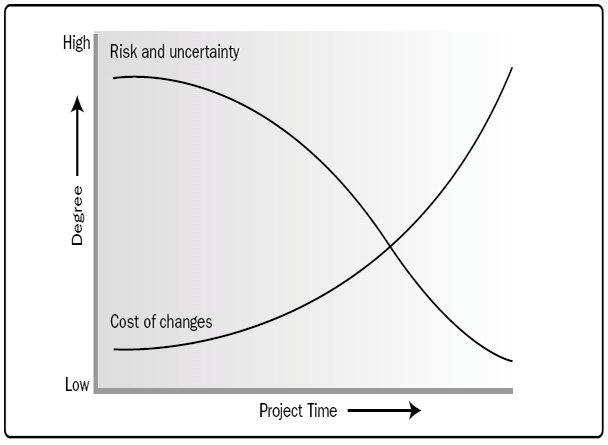Waterfall vs. Pull Processes
There are many different methodologies of project management, all of them are defined by different principles and processes.[1] A traditional, sequential methodology, is the waterfall model. Within this model, the tasks of the project plan are sequenced and conducted in a linear way, one task must be completed before the next one begins - the process is smooth and continuous, like a waterfall.[2] Therefore, this model is one of the simplest methods.[2] However, the pull process-based methodologies are used to create the whole project plan more efficient and effective, it was created to eliminate confounding factors within the project and to avoid aimless work. Hence, the pull processes are used in the management style of Lean Project Management, typical pull processes can be find in the Scrum and Kanban methodologies.[2] This article provides an introduction to the waterfall methodology, to understand the processes within a project plan in a better way. However, the article provides a comparison of the waterfall process (push process) and the pull process. Therefore, no other methodologies e.g. Scrum and Kanban are explained. For the comparison of the two different processes are pros and cons described and the relevance for the practical usage demonstrated.
Importance for Project Management
A project is divided in several phases (except the single-phase project), and five project groups[1].

1. Initiating Process Group:Those processes performed to define a new project or a new phase of an existing project by obtaining authorization to start the project or phase.
2. Planning Process Group: Those processes required to establish the scope of the project, refine the objectives, and define the course of action required to attain the objectives that the project was undertaken to achieve.
3. Executing Process Group: Those processes performed to complete the work defined in the project management plan to satisfy the project specifications.
4. Monitoring and Controlling Process Group: Those processes required to track, review, and regulate the progress and performance of the project; identify any areas in which changes to the plan are required; and initiate the corresponding changes.
5. Closing Process Group: Those processes performed to finalize all activities across all Process Groups to formally close the project or phase.
The project manager has to combine those phases into a flow and take into account the product or service, his team and the customer. To establish a real customer value the project should set up a scope baseline control, build a communication plan to improve the information flow, asses stakeholder needs and get the commitment of the internal stakeholder.[1] As a result, there are many factors which have to be intertwine to each other. Thus, project managers are inclined to overlook something at the beginning of the project and this is when project wastes start building. It is important to align with the customers to establish the customer value, but if the customer is deflect the project team members it will be end in scope creep. As an interim conclusion, the project planning has to consider a lot of things simultaneously, but it is also very important to ponder in which way and rate the steps are executed.

A project life cycle displays typically four characteristics:[1]
1. The costs and staffing level starts at the beginning of the project low, increase when the work is carried out and decrease quickly when the project is going to close.
2. Not all projects describe a typical cost and staffing curve, they may require resources early in its life cycle and therefore higher expenditures.
3. A project starts with a high amount of risk and uncertainty and run low during the ongoing life cycle.
4. The influence to the final product/service starts on an high level with low costs. At the beginning of the cycle the vision can be adjust rapidly and economically, changes at the end of the project will cause high expenses.
With this description of the characteristics of a project life cycle, we can have a look to the different life cycles, which are designed for different purposes. The main difference of the waterfall model and the pull processes is the influence of the stakeholder and the degree of flexibility. Adaptive life cycles keep stakeholders in the loop and let them influence the project in a higher degree than a predictive life cycle (waterfall). Since, the project plan within a adaptive life cycle is more flexible the costs of changes are lower.[1]
The importance to think about the way how to execute the project and how flexible and influenceable it should be is enormous. Therefore, the following chapters will provide some clarity about the choose of process styles.
Waterfall Process
The waterfall model (also known as predictive life cycle or fully plan-driven)[1] is made of a waterfall process, which is defined by sequential relationships. A phase, consisting generally all five process groups, starts only when the previous phase is complete. This approach reduces uncertainty within the project life cycle, but it requests a high amount of tasks. As a result, this process is defined by a huge workload. In addition, the project scope, and the time and the cost required to deliver that scope, are determined at the beginning of the project life cycle. Therefore, the project is inflexible and changes are related to high costs.Cite error: Closing </ref> missing for <ref> tag
Cite error:
<ref> tags exist, but no <references/> tag was found